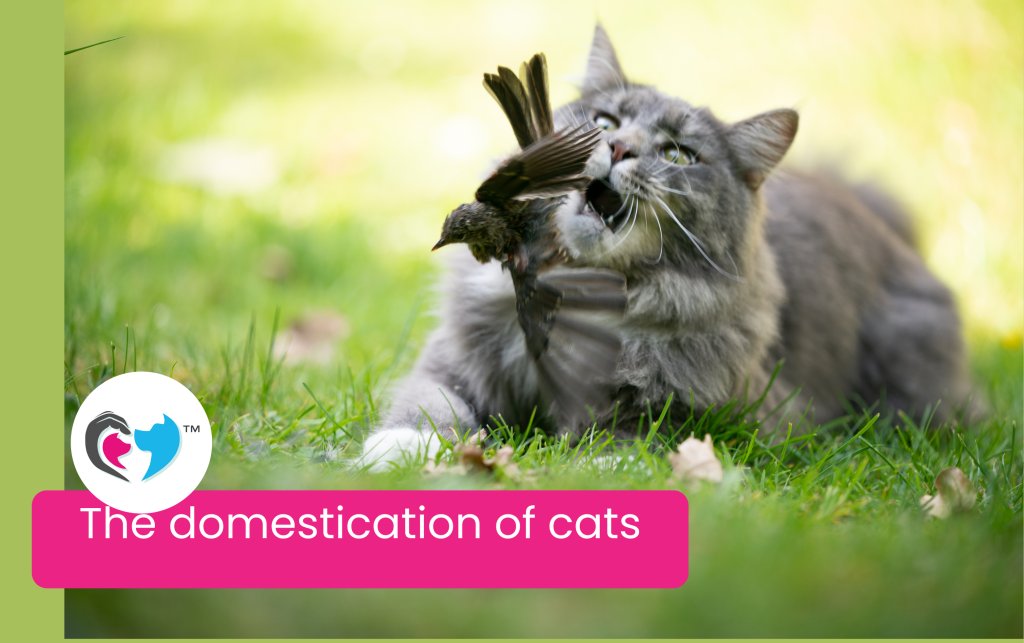

Domestic cats (Felis catus) occupy a fascinating position in human–animal relationships: they are one of the world’s most popular pets, yet retain many behaviours of their wild ancestors. While dogs have been selectively bred for thousands of years to work closely with humans, cats are considered semi-domesticated, with a much shorter history of intentional breeding and behavioural modification.
Origins of Cat Domestication
Archaeological and genetic evidence suggests that the domestication of cats began around 9,000 years ago in the Fertile Crescent in the Middle East (Driscoll et al., 2009). Early agricultural societies stored grain, which attracted rodents. Wildcats (Felis silvestris lybica), the ancestors of domestic cats, were drawn to these rodent-rich environments. Humans tolerated the wildcats because they controlled pests, and over time, a mutually beneficial relationship developed. Unlike dogs, cats were not actively domesticated by selective breeding at the start; instead, they largely domesticated themselves through a process known as commensalism, where animals adapt to living alongside humans without direct human control (Vigne et al., 2016).
Why Cats Retain Hunting Instincts
Even though cats have lived alongside humans for thousands of years, their domestication process has not eliminated their natural predatory behaviours. Hunting is a deeply ingrained instinct, hardwired into their brains through millions of years of evolution as solitary predators (Bradshaw, 2013). Several factors explain why this behaviour persists:
Domestic cats are not fully removed from their wild ancestry, which explains why they continue to hunt despite being provided with regular meals. This instinct is a core part of their behavioural repertoire, shaped by evolutionary pressures and only lightly altered by domestication. Understanding this behaviour can help owners meet their cats’ needs through appropriate enrichment, while also protecting wildlife.
Since hunting is an instinctive behaviour in cats, the goal is not to eliminate it but to redirect it into safe, enriching activities that meet the same behavioural needs.
Simulating hunting behaviour through play is essential. Toys that mimic prey, such as feather wands, mouse-like plush toys, and motorised puzzle toys, can engage a cat’s stalking and chasing instincts. Play sessions should follow the natural “hunt–catch–kill–eat” sequence: encouraging stalking and pouncing, allowing the cat to grab and “kill” the toy, and then ending with a food reward. Short, intense play sessions of five to ten minutes replicate the effort of real hunting (Burn, 2008). Feeding can also be made more enriching by using puzzle feeders, slow feeders, or scatter feeding to encourage foraging behaviour. Offering multiple small meals throughout the day mimics the natural pattern of consuming several small prey items.
Environmental enrichment plays a significant role in reducing hunting motivation. Providing vertical spaces such as shelves, cat trees, and climbing areas allows for exploration and observation. Scent enrichment with cat-safe herbs like catnip, valerian root, or silver vine stimulates curiosity, while window perches overlooking wildlife (with safety measures in place) keep cats mentally engaged, especially for indoor cats.
Finally, meeting a cat’s physical and mental needs helps prevent boredom-driven hunting. Rotating toys regularly, incorporating short positive-reinforcement training sessions, and providing scratching posts and safe chewing items all help keep cats engaged and fulfilled. By combining safe access, simulated hunting, environmental enrichment, and responsible outdoor management, owners can protect wildlife while still ensuring their cats lead enriched, happy lives.